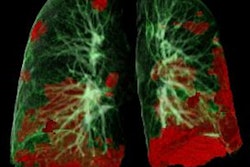
CT shows that more than a third of people who have contracted COVID-19 may experience persistent lung problems up to a year after recovery, a condition commonly known as long COVID, a group of South Korean investigators has found.
The phenomenon, which they called post-acute COVID-19 syndrome, also known as long COVID, underscores the importance of long-term tracking of COVID-19 patients, with either imaging or pulmonary function testing -- or both, wrote a team led by Jong Hyuk Lee, PhD, of Seoul National University Hospital. Lee and colleagues published their findings September 6 in Respiratory Research.
"[Our study showed that] a substantial number of COVID-19 survivors displayed pulmonary sequelae as part of [post-acute COVID-19 syndrome] ... [and] the prevalence of these sequelae did not decrease until one year after initial infection," the group reported. "Considering the association between the severity of acute COVID-19 and risk of pulmonary sequelae, patients who recover from severe COVID-19 require close respiratory follow-up."
Although many people who contract COVID-19 recover relatively quickly, there are some who experience post-acute COVID-19 syndrome, which is defined as either subacute (symptoms such as fatigue, shortness of breath, and cough that continue four to 12 weeks after initial infection) or chronic (symptoms that persist beyond 12 weeks after infection).
But there could be more investigation into the prevalence of chronic pulmonary sequelae such as impaired carbon dioxide/oxygen transfer (diffusion) or lung fibrosis in those who experience longer-term complications from COVID-19, according to Lee and colleagues. To explore the question, the group conducted a review of 30 studies published between January 2020 and December 2021 and found in the PubMed, Embase, and the Cochrane Library databases.
The studies included 6,770 patients who had contracted COVID-19. Of the 30 studies, 25 included pulmonary function testing data on study participants (follow-up duration, between six and 12 months) and 22 had CT data (follow-up duration, between 18 and 24 months).
Pulmonary function testing showed impaired diffusion capacity to be the most common difficulty in COVID-19 patients with persistent symptoms, with a prevalence of 39% at six-month follow-up and 39% at 12-month follow-up.
Follow-up CT showed continued effects from COVID-19 in more than a third of those with post-acute COVID-19 syndrome: Ground-glass opacities and pulmonary fibrosis persisted in 34% of patients at six-month follow-up and 32% of patients at 12-month follow-up.
Lee's group also found that the severity of the initial COVID-19 infection affected the likelihood of patients having lung sequelae at 12 months after recovery, with patients with severe COVID-19 being 1.52 times more likely than those with less severe disease to show impaired diffusion capacity up to one year after initial infection.
The results of the literature review highlight a need to assess which patients can truly benefit from follow-up CT, since the more exams a patient undergoes, the more radiation exposure he or she sustains, the authors explained. And evaluating demographic factors can help.
"Given its expense and radiation risk, chest CT cannot be performed for every symptomatic COVID-19 survivor," they concluded. "In our study, in addition to the severity of acute COVID-19, patients' demographic factors, including age and smoking status, were associated with the prevalence of pulmonary fibrosis, thus suggesting that these demographic factors should be considered when deciding whether chest CT should be performed in certain patients with post-acute COVID-19 syndrome."





















